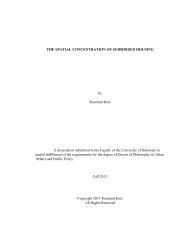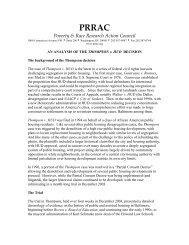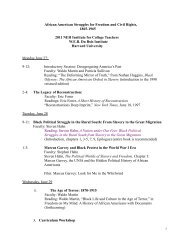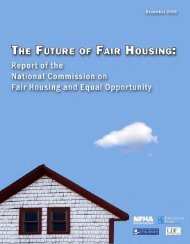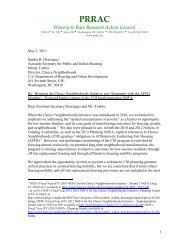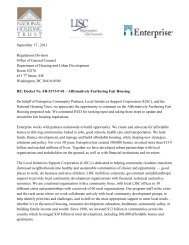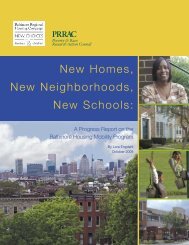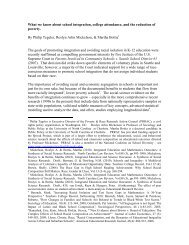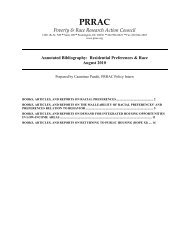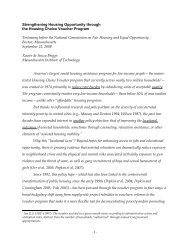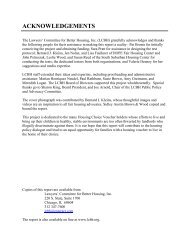Annotated Bibliography of Housing Mobility Research 2006-2010
Annotated Bibliography of Housing Mobility Research 2006-2010
Annotated Bibliography of Housing Mobility Research 2006-2010
Create successful ePaper yourself
Turn your PDF publications into a flip-book with our unique Google optimized e-Paper software.
Summary: O’Neil, the former director <strong>of</strong> CHAC, Inc., <strong>of</strong>fers lessons from her handson experience with<br />
assisted housing mobility and identifies concrete steps that would improve the performance <strong>of</strong><br />
these efforts, including: a wellrun voucher program with policies and procedures that support<br />
mobility counseling efforts; quality <strong>of</strong> life indicators used to define “opportunity areas”;<br />
aggressive fair housing enforcement; incremental measures <strong>of</strong> families’ success; greater family<br />
involvement in the community; return to voucher participant anonymity; and counseling efforts<br />
focused on “second movers.”<br />
Popkin, Susan J., “New Findings on the Benefits and Limitations <strong>of</strong> Assisted <strong>Housing</strong><br />
<strong>Mobility</strong>,” Urban Institute (2008). Available at: http://www.urban.org/publications/901160.html<br />
Popkin, Susan J., Tama Leventhal & Gretchen Weismann, “Girls in the ‘Hood: The<br />
Importance <strong>of</strong> Feeling Safe,” Urban Institute (2008)<br />
Abstract:<br />
The Moving to Opportunity program targeted families living in some <strong>of</strong> the nation's poorest,<br />
highestcrime neighborhoods and <strong>of</strong>fered them a chance to move to lower poverty areas. One hope<br />
was that, away from concentrated poverty and the risks associated with it–including poor physical<br />
and mental health, risky sexual behavior and delinquency–families would fare better. This brief<br />
examines how adolescent girls benefited from moving out <strong>of</strong> high poverty and discusses why girls<br />
might have fared so much better than boys, including the importance <strong>of</strong> feeling safe from<br />
harassment and pressure to become sexually active.<br />
Reece, Jason & Eric Schultheis, POVERTY'S PLACE: The Use <strong>of</strong> Geographic Information<br />
Systems in Poverty Advocacy, 42 CLEARINGHOUSE REVIEW 430 (2009)<br />
Highlights: The use <strong>of</strong> geographic information systems (GIS) gives advocates a powerful way to understand<br />
how laws and policies affect the poor based on where they live. Through the use <strong>of</strong> this computerbased<br />
tool, advocates can visually illustrate adverse effects upon the poor and thus more<br />
effectively focus their advocacy efforts. Understanding how GIS works and how it can be applied<br />
in the real world can both expand the advocacy community's perception <strong>of</strong> the intersection <strong>of</strong><br />
space, place, race, and poverty and further specific advocacy goals.<br />
Summary: Introduces advocates to the concept <strong>of</strong> spatial thinking through geographic information systems<br />
(GIS) and presents case studies on the use <strong>of</strong> GIS to support antipoverty advocacy. The case<br />
studies detail GIS implementation by the Kirwan Institute for the Study <strong>of</strong> Race and Ethnicity, the<br />
Race Equity project, and Legal Services <strong>of</strong> Northern California (LSNC), where GIS technology<br />
was leveraged to serve client needs and organizational policy objectives better. Demonstrates in<br />
practical terms how GIS can further advocacy goals and expand advocacy communities’<br />
understanding <strong>of</strong> the intersection <strong>of</strong> place and poverty.<br />
Roisman, Florence Wagman, Affirmatively Furthering Fair <strong>Housing</strong> in Regional <strong>Housing</strong><br />
Markets: The Baltimore Public <strong>Housing</strong> Desegregation Litigation, 42 WAKE FOREST LAW<br />
REVIEW 333 (2007)<br />
Summary: Argues that racial segregation in public housing has been a “curiously invisible” public issue in<br />
America and that HUD is obligated to “affirmatively further” fair housing and remedy racial<br />
segregation. Provides an overview <strong>of</strong> and introduction to the housing desegregation litigation,<br />
including a discussion <strong>of</strong> housing mobility as a result <strong>of</strong> that litigation. Also considers in some<br />
detail the most recent <strong>of</strong> those cases, Thompson v. HUD, involving Baltimore, MD.<br />
Rosenbaum, James & Stefanie DeLuca, “Does Changing Neighborhoods Change Lives The<br />
16



